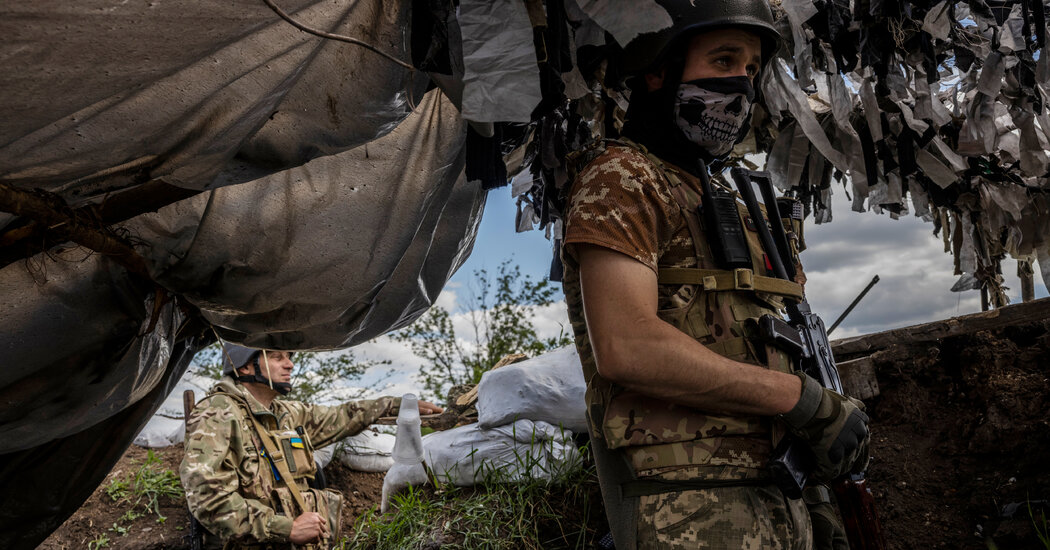
SLOVIANSK, Ukraine — In the waning days of the battle for the eastern city of Sievierodonetsk, a Ukrainian National Guard sergeant had a problem: His platoon’s flank was exposed and he needed to tell his men the Russians were approaching.
But he couldn’t. For 15 soldiers spread across a defensive line stretching roughly 200 yards, he had only two radios. And no matter how much he yelled into the surrounding forest, over the din of artillery and machine gun fire there was no response.
By the time the sergeant, who goes by his nom de guerre, “General,” managed to run to his men’s position, three of them had been killed.
“We did not have a connection to each other,” he said. “We came up to the right flank and the guys who stayed there were already dead.”
As government leaders in Kyiv clamor for more high-tech, longer-range weapons to compete with Russia’s superior firepower, shortcomings on a much smaller but just as important scale are undermining the ability of Ukrainian forces to defend what territory they still hold in the east and retake what they’ve lost.
The breakdown in communication that General’s platoon suffered earlier this month is not an anomaly for Ukrainian forces fighting in the east; it is a widespread issue across the front lines and touches nearly every aspect of the war — coordination on the battlefield, delivering supplies, troop movements.
The New York Times interviewed nearly two dozen Ukrainian soldiers over the last several weeks who all pointed to similar problems: Russians jammed their radios constantly; they didn’t have enough communication gear; and they often had difficulty getting through to a commander to call for artillery support. Talking to units stationed nearby was also an issue, they said, which has led to Ukrainian forces occasionally firing on one another.
“The ability to coordinate different types of forces on the battlefield is essential, but both sides struggle with communications and effective command and control,” said Michael Kofman, the director of Russian studies at C.N.A., a research institute in Arlington, Va.
In 2014, when Russian-backed separatists formed two breakaway republics in the Donbas, the Ukrainian armed forces, built on the model of a Soviet-era military, had to modernize quickly.
Better Understand the Russia-Ukraine War
In the years since, that approach has been lopsided at best. Ukrainian units have procured small, commercial, off-the-shelf drones, and some larger, more modern ones, and they have developed app-based mapping programs that can be used on computer tablets to help direct artillery fire.
But missing was any broader modernization, leaving the Ukrainian armed forces in transition — still anchored to Soviet-era ways even as they sought needed upgrades on the battlefield. That meant brigades of around 4,000 troops still fought independently of one another and the important aspects of battlefield decision making, including empowering lower-ranking officers, remained largely aspirational for many units.
“The important aspects of command and control, along with delegation versus centralization of military functions, remain a work in progress,” Mr. Kofman said.
The grinding war in the east has slowly bled the Ukrainian military of manpower, with officials estimating there are up to 200 casualties a day. As a result, the front lines are increasingly defended by a constant rotation of units composed of less well-trained troops. Those forces, often from the National Guard and Territorial Defense, are placed into the larger brigades, and are quickly told to dig in and defend.
“It’s really bad when some units of the National Guard are suddenly pulled out to be thrown into the front line to reinforce some other units,” said a National Guard ambulance driver named Vadym, stationed in the Donbas. “The guys are staying there without anything, with just rifles.”
Soldiers in those units said they were usually isolated, with little way to communicate with one another as well as with the commander who controls much-needed artillery and tanks. When these replacement units arrived on the front lines, they knew little about nearby forces and referred to them simply as “neighbors.”
“It appears to me that the communication is a bit lopsided, because when we go to carry out some task, we can’t count on artillery support,” said Kostya, a soldier in a Territorial Defense unit who had recently rotated off the front. His company of about 100 men suffered around 30 casualties on their first day at the front.
Asked about communications problems, the general staff of the Ukrainian armed forces did not immediately respond to a request for comment.
In the final days of the battle for Sievierodonetsk, which ended last week when Ukrainian forces retreated to the neighboring city of Lysychansk, the General, 53, was confronted with several communication and institutional issues that illustrated the difficulties faced daily by those troops under withering Russian attacks:
-
A Ukrainian platoon needed artillery to fire on the tanks but could not reach the commander, either because their radios were jammed or they didn’t have a relationship with the commander, so they called the General.
“As I was finding out if it was possible to call artillery support, the drone ran out of power,” the General said. “Then the generator broke, so they could not charge it, and we ran out of time, I don’t really remember now. And the tank was driving around as before, pounding us.”
Frontline Ukrainian troops are often unable to communicate with the artillery units supporting them with howitzers and multiple rocket launchers. That prompts those artillery units to often rely on their own drones and often U.S.-supplied intelligence, soldiers and U.S. defense officials said. This disconnect has left soldiers on the front lines increasingly on their own, prone to taking casualties, and has made some artillery batteries slow to react to Russian breaches along the front line.
“What artillery shall we ask for support?” one soldier said after coming off the front near the eastern city of Bakhmut, requesting that he not be identified for security reasons. Adding that “we don’t have communications,” and that his side’s artillery “shot two times, and we were hit 300 more times.”
This breakdown between troops and units, where a shared understanding of what’s happening on the battlefield is difficult for any standing military, has been exacerbated by Russia’s technologically superior military. Not only can Moscow’s troops unleash far more artillery fire, but they also have proven effective at jamming communications.
The General said that his two off-the-shelf radios were jammed constantly.
“They would use the stronger signal on the same frequency,” he said.
Troops in more specialized units have been issued U.S.-supplied encrypted radios and can speak to one another unhindered, one soldier said, but the radio’s high output means the Russians can find the locations they are broadcasting from.
“This is why we stopped communicating and only communicated the necessary minimum, such as if an evacuation was needed or an urgent help,” the soldier, who goes by the name Raccoon, added. Only about a quarter of the secure radios that Ukraine needs have been sent by the United States and other allies, a Western adviser in Ukraine said, requesting anonymity to discuss sensitive military details.
Soldiers say the most reliable equipment they’ve received, though in small quantities, has been Starlink satellite internet, enabled by a small square-like antenna that can be connected to act much like any Wi-Fi network.
But even the presence of satellite internet, which so far the Russians have not been able to jam, has not been a cure-all. The murky images from the front have sometimes turned deadly, with Ukrainian forces mistakenly turning their weapons on one another.
A foreign fighter stationed in the eastern Kharkiv region recalled a recent incident where a half-dozen Ukrainian units were stationed in a roughly two-mile-wide section of woods and fired on each other, killing two friendly soldiers.
“None of them communicate with each other,” the foreign fighter, a former British Royal marine, said.
The General faced similar issues during the defense of Sievierodonetsk when his platoon was on the front line near a small river. On the opposite bank was another platoon with which he had no way to communicate. So almost every time the enemy attacked, the other unit would not just shoot at the Russians but also, unknowingly, at the General’s men who were in the line of fire — with everything from rifles to heavy machine guns.
“Nobody knew how to connect with them,” the General said. “Every day as we were standing there, for over 20 days, as far as I understood, nobody could connect to that unit next to us and let them know they were firing on their own.”
Eric Schmitt contributed reporting from Washington.




